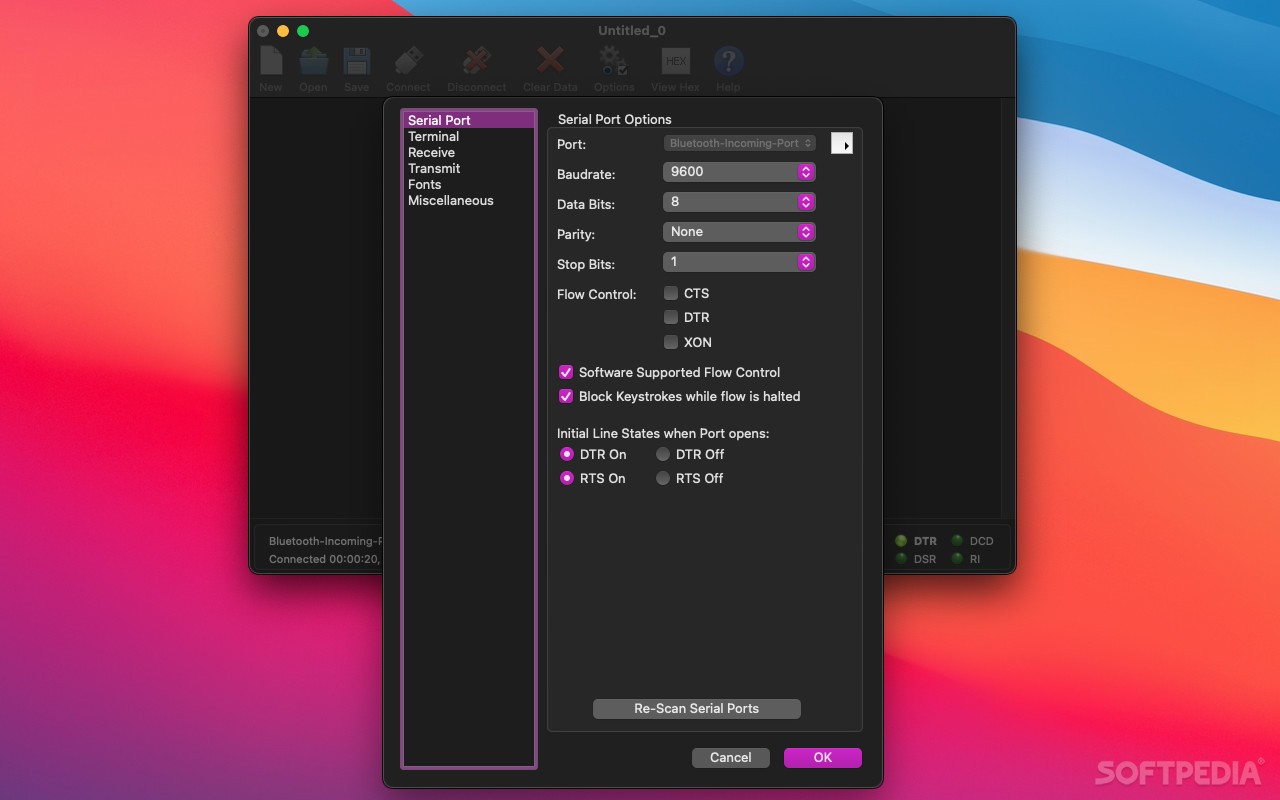
- COOLTERM MACOS SERIAL SETTINGS MAC OS X
- COOLTERM MACOS SERIAL SETTINGS INSTALL
- COOLTERM MACOS SERIAL SETTINGS SERIAL
- COOLTERM MACOS SERIAL SETTINGS DRIVERS
- COOLTERM MACOS SERIAL SETTINGS PASSWORD
Alternatively, you can send different commands to the connected hardware either using files or commands and check out the returning responses on your screen. The interface is clean and straight-forward and displays all the messages received text or ASCII if needed. Keep in mind the application isn't actually emulating a terminal. You can configure anything serial-port related such as the baud rate, port number, parity and more and supports both raw and line mode.
COOLTERM MACOS SERIAL SETTINGS INSTALL
The application easy to install but it requires a certain degree of setting-up and knowledge.
COOLTERM MACOS SERIAL SETTINGS SERIAL
This photo shows the Micro Controller Shop’s FTDI based 3.3V Usb-to-Serial adapter cable, powering the Raspberry Pi, as well as connecting to its TXD and RXD pins.A simple serial port terminal applicationĬoolTerm is a pretty handy serial port terminal application that allows professionals and hobbyists alike to transfer data between various hardware using the serial ports. The 3.3V TTL signals are color coded as follows: The USB-to-Serial cable (uses an FTDI FT232RQ) is a USB-to-Serial (3.3V TTL level) converter cable which allows for a simple way to connect 3.3V TTL interface devices to USB. Adafruit has one as well here.Ĭable like these are the easiest way ever to connect to the Raspberry Pi’s serial console port, since they can also power the Raspi. If you look hard and long enough, you will find USB-to-Serial Cable, 6 Female Header Wires, 3.3V I/O, like this one over here at Micro Controller Shop. Still, the Raspberry Pi needs to be powered through its micro-usb port.

Again, the FTDI Basic is powered through the USB connection coming from your host PC or Laptop. This photo shows the FTDI Basic 3.3V Usb-to-Serial adapter, with only two (TXD and RXD) pins connected to the Raspberry Pi. Since the FTDI Basic does’t need to be powered, only the TXD and RXD pins need to be connected.
COOLTERM MACOS SERIAL SETTINGS DRIVERS
The Virtual COM Port Drivers (VCP-Drivers) for the host computer are available here Big benefit here is that the FTDI Basic 3.3V already provides the 3.3V levels that the Raspbi requires. It can of course also be used for general serial applications. I have a basic breakout board for the FTDI FT232RL USB to serial IC, which is mainly used to program those Arduino boards that don’t have an USB connector. A more dedicated application like CoolTerm may become handy as well. On OS X, a simple Terminal with the screen /dev/tty.usbserial 115200 command issued is all what is needed to connect to the Raspberry Pi. Yellow and Orange are used for the Transmit and Receive lines. Since the level shifter needs to be powered, the Raspi’s 3.3V pin (red) and Ground (black) are connected to the Level-Shifter. This photo shows the blue Zonet ZUC3100 Usb-to-Serial adapter, with a Maxim MAX3232 based level shifter. Since the Raspi wants no more than 3.3V, TTL-RS-232 level converters based on the Maxim MAX3232 are your best choice. Very few of those USB-to-Serial adapters have the standard RS-232 +/- 12V voltage levels on the serial ports (the Zonet ZUC3100 w/ the pl2303 chip however does!) and using a level shifter is certainly a very good idea.
COOLTERM MACOS SERIAL SETTINGS MAC OS X
I’m currently using the Mac OS X Universal Binary Driver v1.4.0 on OS X 10.8.1 without any issues.
COOLTERM MACOS SERIAL SETTINGS PASSWORD
Drivers for 2303 based devices can be found here, if required, use GUEST as user name and password to gain access.Į.g.

However, adapters based on the Prolific 2303 chip, like the Zonet ZUC3100, seem to be a little less expensive, well-supported in Linux, and much more widespread. There are many USB-to-Serial adapters available and while not all of them are capable to handle the highest data transfer speeds, the Keyspan HS-19 (OS-X drivers are available here) is certainly one of the best. I have recently connected to the Raspberry Pi using three different hardware setups. Since most of the desktop and laptop computers don’t come equipped with a serial port anymore, accessing the Raspberry Pi via a Serial Connection requires some requisites.

UART TXD and RXD pins are easily accessible (GPIO 14 and 15), however, like for all GPIO pins, the voltage levels are 3.3 V and are not 5 V tolerant! the serial connection allows logging-in form a remote computer without running an SSH daemon on the Raspi. Once booted, you can of course login through a serial terminal as well, i.e. The boot process (Kernel boot messages go to the UART at 115,200 bit/s) can be monitored, without the need to hookup an HDMI-Monitor. Using a serial connection to connect to a Raspbery Pi has many advantages.


 0 kommentar(er)
0 kommentar(er)
